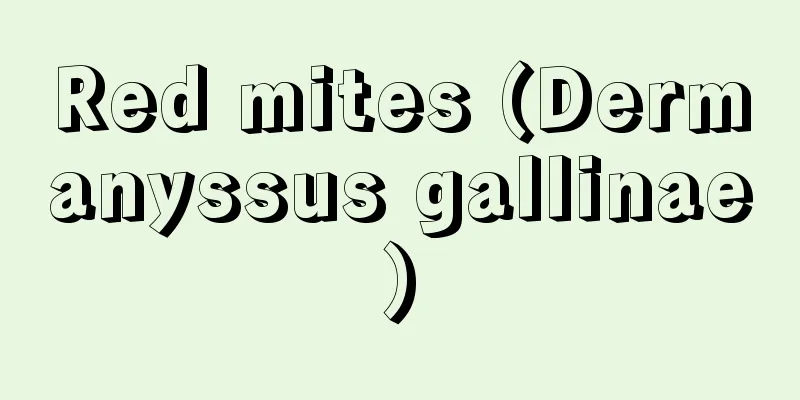Plutonic rock - Shinseigan (English spelling) plutonic rock

|
Among igneous rocks, this type has large crystal grains of constituent minerals, is holocrystalline, and has a coarse texture. The name is based on the idea that magma slowly solidified "deep" underground, but in reality it is often found closely associated with fine-grained volcanic rocks, and the coarse texture does not correspond to the depth of formation. Therefore, some people are of the opinion that the term plutonic rock should be abolished and called coarse-grained rock instead. [Mitsuo Hashimoto] ClassificationThe minerals in plutonic rocks include colorless minerals such as quartz and feldspar, and colored minerals such as mica, amphibole, pyroxene, and olivine. Plutonic rocks are divided into two groups based on whether the amount of colored minerals reaches 40% of the total rock. The group with fewer colored minerals is further divided by the combination of colorless minerals, and the group with more colored minerals is further divided by the combination of colored minerals. [Mitsuo Hashimoto] Plutonic rock with few colored mineralsA plutonic rock that is less than 40% colored minerals and contains quartz as one of its main components is granite in the broad sense. Granite is mainly composed of quartz and feldspar, and feldspar includes potassium feldspar and plagioclase. Depending on the combination of these, it is classified as follows: (1) Granite is characterized by the combination of potassium feldspar and quartz. It usually contains a small amount of biotite. (2) Quartz diorite is a rock whose feldspar is almost exclusively plagioclase. This group is somewhat rich in colored minerals, namely biotite and hornblende. (3) Regarding feldspar, granodiorite is intermediate between the two, and most of what is called granite in Japan is this type of rock. The main colored mineral is biotite, but it often also contains hornblende. Plutonic rocks containing less than 40% colored minerals and containing little quartz can be divided into the following categories: (4) Diorite is a rock in which all the feldspar is plagioclase. The colored minerals are mostly hornblende, and often contain calcite. (5) If the colorless minerals are all potassium feldspar, then it is a syenite. Rocks in this group are often very rich in alkalies (Na 2 O and K 2 O) and therefore contain minerals undersaturated with silicon dioxide (SiO 2 ), such as nepheline. These are called nepheline syenites. (6) A rock that contains approximately equal amounts of potassium feldspar and plagioclase is called monzonite. [Mitsuo Hashimoto] Plutonic rock containing a lot of colored mineralsWhen the colored minerals exceed 40%, the rock's visible color becomes dark. Gabbro and peridotite belong to this group. The colorless minerals are almost exclusively plagioclase, and quartz and potassium feldspar are usually absent. (1) A plutonic rock consisting of plagioclase and pyroxene is called gabbro. Pyroxene can be classified as orthopyroxene or clinopyroxene. A gabbro containing only the former is called norite, a gabbro containing only the latter is called regular gabbro, and a gabbro containing both is called eucrite. There are also gabbros that contain more hornblende than pyroxene, and these are called hornblende gabbro. (2) Gabbro that contains olivine in addition to pyroxene and plagioclase is called olivine norite, olivine regular gabbro, and olivine eucrite, respectively, with the word olivine added before the above names. (3) Coarse-grained rocks that contain little or no colorless minerals and are composed mainly of olivine and pyroxene are called olivine or peridotite. This type of rock is also called ultramafic rocks because it is extremely poor in silicon dioxide in its chemical composition. It is also called ultramafic rocks or ultraferromagnesian rocks because it is rich in magnesium oxide (MgO) and iron (FeO and Fe 2 O 3 ). Magnesium and magnesia are magnesium oxides. Peridotites are classified and named in various ways, such as dunite, harzburgite, wehrleite, and lherzolite, depending on the combination and ratio of olivine, orthopyroxene, and clinopyroxene. There is also cortlandite, which is composed of ordinary hornblende and olivine. Some peridotites are not strictly igneous rocks because they were brought down in solid form from the upper mantle and were not formed by the solidification of magma, but because they are composed of olivine and pyroxene and are coarse-grained, they have traditionally been considered plutonic rocks. [Mitsuo Hashimoto] "Yamazaki Sadaharu, 'Encountering Petrology for the First Time - An Invitation to Igneous Rock Petrology' (1990, Kyoritsu Publishing)" ▽ "Geological Standards, edited by the Geological Standards Committee of the Geological Society of Japan (2001, Kyoritsu Publishing)" [Reference items] | | | | | | | Mafic rock | | | | | | |Made in Mannari, Okayama City, Okayama Prefecture ©Shogakukan granite Produced in Inada, Kasama City, Ibaraki Prefecture ©Shogakukan Diorite Made in Muroto Cape, Muroto City, Kochi Prefecture ©Shogakukan Gabbro Produced in Urakawa-cho, Urakawa-gun, Hokkaido ©Shogakukan "> Peridot Source: Shogakukan Encyclopedia Nipponica About Encyclopedia Nipponica Information | Legend |
|
火成岩のなかで、構成鉱物の結晶粒が大きく、完晶質で組織の粗いもの。マグマが地下「深く」でゆっくり固結したものという考えに基づいた名前であるが、実際には細粒の火山岩と密接に伴って産することも少なくなく、組織の粗さと生成の深さとは対応しない。そこで、深成岩という語を廃して、粗粒岩とよぶ意見もある。 [橋本光男] 分類深成岩の鉱物には、石英や長石のような無色鉱物と、雲母(うんも)、角閃(かくせん)石、輝石、橄欖(かんらん)石などの有色鉱物とがある。そして、有色鉱物の量が岩石全体の40%に達するか否かによって、深成岩を二つのグループに分ける。有色鉱物の少ないグループは無色鉱物の組合せにより、多いグループは有色鉱物の組合せによってさらに細分される。 [橋本光男] 有色鉱物の少ない深成岩有色鉱物が40%に満たないもので、石英を主成分の一つとして含む深成岩は、広義の花崗(かこう)岩である。花崗岩は石英と長石を主成分とするが、長石にはカリウム長石(カリ長石)と斜長石とがある。それらの組合せにより次のように分類される。 (1)長石がもっぱらカリウム長石であって、それと石英の組合せで特徴づけられるものは狭義の花崗岩とよばれる。これは普通、少量の黒雲母を含む。 (2)長石がほとんど斜長石のみであるものは石英閃緑岩という。このグループは有色鉱物にやや富み、それは黒雲母と普通角閃石である。 (3)長石について両者の中間的なものは花崗閃緑岩で、日本で花崗岩といわれているものの多くはこの種の岩石である。有色鉱物としては黒雲母が主であるが、しばしば普通角閃石をも含む。 有色鉱物が40%に達しない深成岩で、石英をほとんど含まないものは、次のように分けられる。 (4)長石がすべて斜長石であるものは閃緑岩という。有色鉱物はほとんど普通角閃石で、しばしばカルシウム輝石をも含む。 (5)無色鉱物がすべてカリウム長石であるものは閃長岩である。このグループの岩石はしばしばアルカリ(Na2OとK2O)に著しく富み、そのため霞(かすみ)石のように二酸化ケイ素SiO2(シリカ)に不飽和な鉱物を含むようになる。これが霞石閃長岩である。 (6)カリウム長石と斜長石とをほぼ等量に含むものはモンゾニ岩という。 [橋本光男] 有色鉱物を多く含む深成岩有色鉱物が40%を超えると、岩石の肉眼的色調は暗くなる。斑糲岩(はんれいがん)や橄欖岩がこのグループに含まれる。無色鉱物はほとんど斜長石のみで、石英やカリウム長石は普通は含まれない。 (1)斜長石と輝石とからなる深成岩を斑糲岩という。輝石には斜方輝石と単斜輝石とがあり、前者のみを含む斑糲岩をノーライト、後者のみのものを正規斑糲岩、両者をともに含むものをユークライトという。輝石よりも普通角閃石を主として含む斑糲岩もあって、それは角閃石斑糲岩という。 (2)輝石と斜長石のほかに橄欖石が加わった斑糲岩は、前記の名称の前に橄欖石を付して、それぞれ、橄欖石ノーライト、橄欖石正規斑糲岩および橄欖石ユークライトとよぶ。 (3)無色鉱物をほとんど、あるいはまったく含まず、もっぱら橄欖石と輝石からなる粗粒の岩石を橄欖岩またはペリドタイトという。この種の岩石は化学組成において二酸化ケイ素に著しく乏しいので、超塩基性岩ともよばれる。また、酸化マグネシウムMgO(マグネシア)や鉄(FeOとFe2O3)に富むため、超苦鉄質岩あるいは超鉄苦土質岩ということもある。苦や苦土は酸化マグネシウムのことである。ペリドタイトは橄欖石、斜方輝石、単斜輝石の組合せや量比によって、ダナイト、ハルツバージャイト、ウェールライト、レールゾライトなどいろいろに分類、命名されている。そのほか、普通角閃石と橄欖石からなるコートランダイトなどもある。 ペリドタイトの一部は、上部マントルから固体のままでもたらされたもので、マグマの固結によって生成したものではないので、厳密には火成岩ではない。しかし、橄欖石や輝石からなり、粗粒であることなどから、慣習上、深成岩とされてきた。 [橋本光男] 『山崎貞治著『はじめて出会う岩石学――火成岩岩石学への招待』(1990・共立出版)』▽『日本地質学会地質基準委員会編著『地質基準』(2001・共立出版)』 [参照項目] | | | | | | | | | | | | | | | | | |岡山県岡山市万成産©Shogakukan"> 花崗岩 茨城県笠間市稲田産©Shogakukan"> 閃緑岩 高知県室戸市 室戸岬産©Shogakukan"> 斑糲岩 北海道浦河郡浦河町産©Shogakukan"> 橄欖岩 出典 小学館 日本大百科全書(ニッポニカ)日本大百科全書(ニッポニカ)について 情報 | 凡例 |
>>: New Life Movement - New Life Movement
Recommend
Empathy - kanjouinyuu
This word is a translation of the German word Ein...
Fraxinus excelsior (English spelling)
… [Yukio Taniguchi]. … *Some of the terminology e...
Xu Guangqi - Jokkoukei
A Chinese scholar and politician at the end of th...
Katsurahara Tomb - Kazuwara Kofun
...The fishing industry is based at Matsuai Fishi...
Shiro Inoue - Inoue Shiro
Year of death: Bunka 9.5.16 (1812.6.24) Year of bi...
Alumina refractory bricks - Alumina refractory bricks
...Refractories that have been molded into a spec...
Chemical Medicine - Kagakute Kiigakuha
...However, it is certain that he was the origina...
lotus eater
…On the other hand, there is a legend in ancient ...
Eiki
For example, the word "pulse" can mean ...
Grands Rhétoriqueurs (English)
…Most of Dufay's chansons, about 70 in total,...
Kikuyu people - Kikuyu (English spelling)
A Bantu-speaking ethnic group living in the southe...
lay-off
...In the case of temporary leave, the Labor Stan...
Deer - Deer
A general term for mammals of the Cervidae family ...
Beekeeping - beekeeping
It refers to the practice of raising honeybees to...
Collective behavior
Collective behavior refers to a wide range of soci...









